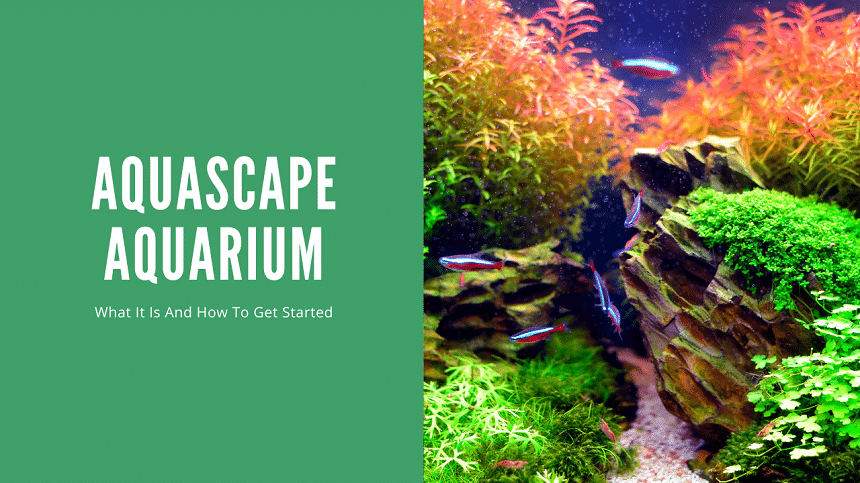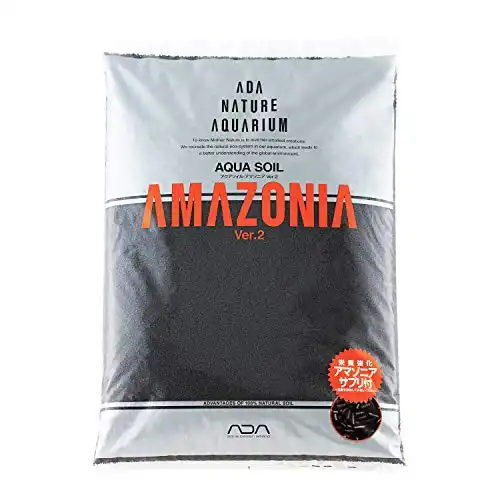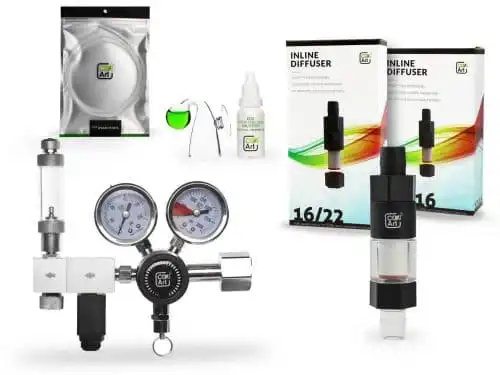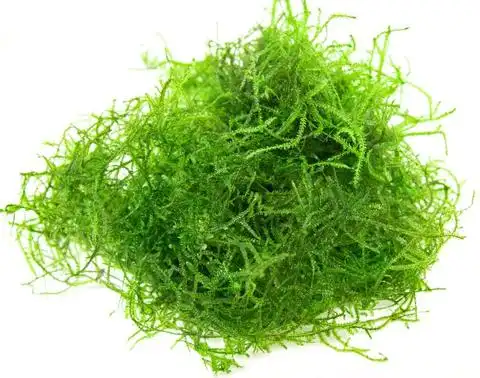Thank you for visiting! By the way… any links on this page that lead to products on Amazon and other stores/partners are affiliate links Aquarium Store Depot earns a commission if you make a purchase.
Are you ready to start an incredible journey into the world of aquascaping? For many people, an aquascape aquarium is more than just a hobby, it’s also a connection to nature.
In this article, I’ll be introducing you to the world of aquascaping and teaching you all the key concepts you need to know to get started. This is one of my favorite subjects in the hobby, and frankly I feel it is an underrated technique in the aquarium hobby in the US. In the US, we focus so much on reefing as the pinnacle of the aquarium hobby. Aquascaping has the ability to be show stopping and creates a very special connection to nature. Let’s dive into the subject more with the first question.
What Is An Aquascape Aquarium?
Aquascaping is an art, a passion, and a science all rolled into one fascinating pastime. Essentially aquascaping is a form of gardening and fishkeeping, in 3 dimensions, all within the four walls of the aquarium!
It involves designing beautiful and aesthetically pleasing environments that mimic natural landscapes. The hobby has come a long way, and innovative pioneers have constantly experimented and worked towards the goal of more beautiful and awe-inspiring planted aquariums.
Why Start Aquascaping?
Aquascaping is a challenging and rewarding activity that many of us find completely addictive. There are no limits to how far you can go with this hobby.
Many people start fishkeeping and move on to aquascaping. It calls for creativity and an artistic eye, as well as an understanding of biology.
Aquascaping is a really absorbing hobby. You will learn through trial and error. It helps you to destress and forget all about life’s challenges, providing real serenity and relaxation.
Amazingly, aquascaping also provides a connection with nature, even if your tank is in the living room of your apartment, high above the ground in a busy city. These are the reasons we aquascape!
The History
No discussion on the topic of aquascaping would be complete without explaining how it all started. For this, we have to pay tribute to the most important contributor to the hobby, Mr. Takashi Amano from Japan1.
Takashi is legendary for popularizing the nature-style aquarium and making the hobby accessible with his books on aquascaping, and by displaying his tanks. He was a pioneer in our history and brought the zen like nature to aquascapes that you see today. He created incredible scapes. You can see an example of these scapes at the ADA Museum in Japan. Above is a video of Takashi and the ADA Museum (Video Source).
He founded ADA (Aqua Design Amano) way back in 1984 and the innovative, high-quality products they developed are still produced and extremely popular in the hobby today.
Design Concepts
Designing the layout of your aquascape is all about following clues from nature, harnessing your creativity, and finding what suits your own eye. There are a few proven tips that help to create a space with a truly aesthetic appeal, however.
I’ll run you through a brief introduction on some of these techniques that you can incorporate into your planning process.
The Rule of Thirds
The rule of thirds is a visual technique used in composing paintings, photography, and other art forms. Here’s a pro tip, it works amazing for aquascaping too!
It works on the principle that the human eye finds features in a scene that are located slightly off-center the most appealing. The focal point positions that really catch our attention are combinations of the upper and lower, and left and right thirds of the scene. Here is a video below by Julian Discovers explaining the concept.
If you have a smartphone, the grid mode in the camera settings is very useful for finding these areas of interest. Where the lines of the grid intersect is where you should create a focal point with things like dominant hardscape features, or interesting specimen plants.
The Golden Ratio
If you’re interested in the rule of thirds and want to look deeper into this visual technique, you need to understand the golden ratio. The golden ratio, or Fibonacci spiral, is a mathematical concept that can be expressed as 1:1.618. Here is a video below by Mark Denny explaining how the golden ratio works in photography.
The rule of thirds is roughly based on this ratio. In a scene that follows this ratio, the form follows a smooth curve, similar to a rolling wave on the ocean, with the focal point being in the center of the wave, located near one of the intersections of the grid described above.
Use Of Depth
The aquascape is a 3-dimensional space, which means it is possible to create a sense of depth in the tank. A simple and effective way to enhance the feeling of depth is to slope the substrate from the front to the back.
By sloping the bottom of the tank, and planting creatively, it is possible to make the tank look almost infinitely deep. Using low-growing aquarium plants in the front of the tank and progressing to taller plants in the middle ground and then tall plants in the background is another very effective way to create a sense of depth.
Styles
Although there are no rules or limits to the type of aquascapes you can create, there are a few popular freshwater aquascaping styles that are proven winners. If you’re new to aquascaping, basing your tank on one of these styles is a great way to start.
Let’s take a quick look at these styles:
- Dutch Aquarium
- Jungle Style
- Biotope
- Nature Aquarium
- Iwagumi
- Ryoboku
The Dutch Style

The Dutch aquarium is a very ordered style that appeals to more formal aquatic gardeners. Dutch-style aquascapes are all about the plants. This planted aquarium design focuses on the beauty of the plants and their arrangement, rather than trying to recreate nature.
Hardscape features are less important in this aquascape style and often are not very visible at all. Dutch tanks are very heavily planted, with the different species arranged and grouped carefully to contrast and complement each other with different textures, colors, and shapes.
The Biotope
Biotope aquascapes are basically a way of recreating a scene from nature as accurately as possible. This could be a local pond or river bank near your house or a few square feet of the mighty Amazon river!
Biotopes don’t only look like a tiny portion of a wild aquatic scene, they should also have the same kind of substrates, species of plants, and fish that would be found there.
Some examples of popular biotopes include:
- Hillstream
- Amazon River
- West African
- Malaysian
- Blackwater
Jungle Style
This type of aquascape is styled in the wild and chaotic manner of the jungle. It’s a lively design that needs plenty of planning but involves less maintenance in the long run since the plants are allowed the freedom to grow out in their natural way.
Jungle-style aquascapes are full, busy tanks with tall, large-leaved plants and limited visible hardscape, mostly in the form of driftwood.
The Nature Style
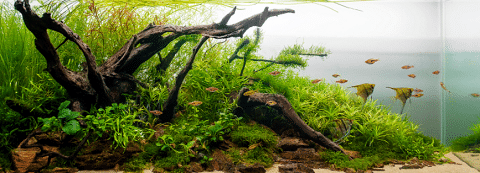
The nature aquarium is the style popularized by Takashi Amano. It does not seek to mirror a natural scene quite as accurately as a biotope aquascape but rather to create a harmonious underwater world that is visually pleasing to the human eye.
A key concept in the nature aquarium is the principle of Wabi-Sabi, which translates from Japanese as ‘perfection in imperfection’. The nature style aims to create an aesthetically pleasing aquascape that lies somewhere between the order of the Dutch-style planted tank and the untamed appearance of the Jungle aquascape.
Iwagumi And Ryoboku

The Iwagumi and Ryoboku style aquascapes are minimalist designs that have plenty of open space and place the most emphasis on the hardscape. In the case of the Iwagumi aquascape, the hardscape is made up of a carefully arranged rock formation.
Usually, an odd number of main stones and smaller stones are used and each has its own significance and name. Carpeting plants are the most important plant component used in Iwagumi style aquascapes.
The Ryoboku is similar to the Iwagumi style but uses wooden elements like driftwood as the central focus that the aquascape is built around.
How To Set Up
Aquascaping is a long-term hobby, and the most important part of setting up an aquascape is planning! Try not to be tempted to rush the planning and jump into setting up too quickly.
When it comes to aquascaping, the planning process is actually fascinating and loads of fun, so take your time with it!
Let’s take a look at the basic elements of any aquascaped aquarium:
The Tank
Many aquascape aquariums will use a rimless tank these days. These tanks have low iron aquarium glass that has better clarity than traditional glass. In an aquarium where looks are everything, a well designed rimless tank really helps with the look. Standard braced tanks can look old fashioned and tuned down with the hue on the glass. If you are getting really serious about aquascaping, consider a rimless with iron low glass. UNS aquariums is one of the best out there.
Editor's Choice!
A world class rimless aquarium. Available in many sizes and shipped direct to your door
Hardscape
The hardscape is the cornerstone of any beautiful aquascape. It is the foundation and the backbone of your layout, so make sure you spend plenty of time experimenting with different materials and arrangements.
As the name suggests, the hardscape is made out of hard materials. These are usually either wood or rock. You can also use aquarium ornaments as part of your aquascape, but be careful to keep the tank looking as natural as possible for a really great aquascape.
You can collect your own materials, but not just any rocks or wood will work in an aquarium. To start out, I would suggest using these materials:
- Dragon stone
- Lava rock
- Seiryu stone
- Petrified wood
- Spider wood
- Pacific wood
- Amazon wood
Online retailers can stock an awesome range of hardscape materials that you can check out. One of the bigger frustrations for me personally is the lack of aquascaping specialized stores in the US. Online is the way to go!
Editor's Choice
Ohko is the premier aquascaping rock today. Granite based with amazing shapes and selection
Substrate
The substrate is another essential part of any aquascape. For the purpose of this article, the term substrate means the gravel/soil/sand at the bottom of the tank.
Now, not all substrates are suitable for aquascaping, and the different varieties have different properties and uses. You should definitely avoid unnatural-looking substrates like multi-colored gravel, as this will not be aesthetically pleasing.
The most simple way to categorize aquascape substrates would be between materials that contain nutrients and those that don’t. Let’s take a closer look at what this means:
Active Soils
Active soils are usually clay-based and contain the essential nutrients that plants need to grow. They can be expensive, but I would definitely recommend going this route if you want to be successful from the start. There are many great products on the market, including:
- UNS controsoil
- Tropica Aquarium Soil
- ADA Amazonia
The Best Planted Tank Substrate
The world's standard in active substrates for planted tanks. Created by brand that founded modern aquascaping
Inert Substrates
Inert substrates are materials that do not interact with the water by changing the pH or releasing minerals and nutrients. Plants will not get any nutrients from this kind of substrate so dosing a fertilizer, or using root tabs will be very important.
Sand and gravel with varying grain sizes are the best examples of inert substrates. One of the best ways to use inert substrates is as a cap over the top of active soils. You can also use them as a decorative layer. Sand is a really good aesthetic enhancer in aquascapes to create trails and contrast.
Natural sand is excellent for bottom feeder fish to forage around in.
Lighting
Lighting in the aquascape serves two different functions. It makes the viewing experience better, and most importantly, it allows your plants to photosynthesize. The needs of your plants are definitely the first priority when choosing aquarium lighting.
Not just any kind of light will work, so make sure you set up lighting specifically designed for growing aquatic plants. It needs to have the right strength and frequency for the size of your tank and the kinds of plants you want to grow. I find the Serene RGB as the most beginner friendly LED light on the market. You can grow just about anything with it and the price is very reasonable.
Current USA's offering into aquascaping is an incredible value. Spectrum, spread, easy to program and great PAR output.
A good tip for beginners is to choose lighting that covers the minimum needs of your plants, rather than going overboard with very high lighting. Remember, with too much light, algae can easily get out of control, but without enough light, your plants will not grow to their full potential.
Your lights will need to run on a timer that comes on automatically at the same time each day. Aquarists usually run 6-10 hours of light, with 8 hours being pretty ideal.
The Importance of CO2
CO2 (carbon dioxide) is the gas that plants use during photosynthesis. Without this gas, your plants simply can’t live and grow.
CO2 is all around us and occurs naturally in your aquarium water. The natural concentration is enough for some plants to grow, but pretty much all plants will benefit from increased levels, and many types of plants won’t grow well at all without running a pressurized CO2 system.
Pretty much all of the incredible and jaw-dropping aquascapes you will see run with injected CO2. Unfortunately, pressurized CO2 systems are expensive, but if you want to get serious about the hobby, start out in the right way with this investment. If are are shopping for an option, you can’t go wrong with CO2art. Check out my offer code ASD10%Off for an extra discount.
Use Offer Code ASD10%Off
The highest end offering by CO2Art. This package includes everything you need to perform consistent and the highest quality CO2 injection in the industry!
These systems allow you to run a stable and measured level of carbon dioxide. Levels of up to 30 ppm will promote incredible plant health and growth, while not affecting your fish and other livestock.
That being said, there are many aquatic plants that you can grow without running CO2 in your tank, so with some careful planning and research, you can easily start out with a low-tech fish tank.
Filtration
Good filtration is hugely important in any aquarium. Planted aquascapes need very good filtration because both fish waste and rotting plant material can foul the water and cause dangerous ammonia spikes. There are a few different types of filters available in the hobby, and just about any style can be used.
The best filter types for aquascapes are external filters because you really want to minimize the amount of hardware visible in the aquarium. The most popular styles are external hang-on back (HOB) filters and canister filters.
Canister filters tend to be more expensive but allow the aquarist much greater control over the filter media selection, and most importantly, they can be kept out of sight in the cabinet below the aquarium.
Plants
Live plants are what really make an aquascape. Sure, you can create some beautiful hardscape layouts, but healthy plants are what bring the scene to life.
Pretty much any kind of aquarium plant can be used in the aquascape. The texture of the foliage can have a big impact on the feel of the aquascape though. A nano aquarium with only large leaf plants can look even smaller than it is, so these plants should ideally be used in a larger aquarium.
Small plants with fine leaves can be used to create a space that feels a lot larger, especially when the hardscape and substrate are arranged in ways that enhance this perception.
There are an amazing variety of plants available in the hobby and I recommend a solid online retailer like BucePlant for buying new plants because they offer such a comprehensive range of healthy, high-quality stock.
Let’s take a look at some of the most important types of plants for aquascapers.
Stem Plants
Stem plants are usually taller, fast-growing plants that take nutrients from the substrate and the water column. Stem plants are a very important component of Dutch aquascapes and usually work well as background plants. Some great examples include:
Epiphytes And Mosses
Epiphytes are plants that do not grow rooted in the substrate but are grown attached to the hardscape instead. Epiphytes tend to be slow-growing, and are great plants to start out with as they can be very easy to maintain.
Mosses also grow attached to hardscape. Mosses like Java moss can also be left to float around the tank, although floating plants can look a little untidy in a carefully scaped aquarium.
One of the easiest mosses to grow in an aquarium. Great for small fish and shrimp
These kinds of plants work excellent in nature and jungle-style aquascapes. Great examples of this type of plant include:
Grass/Carpet Plants
Plants that cover the bottom of the tank like a lawn are usually known as carpeting plants in the hobby. These plants are characteristic of Iwagumi and Ryoboku style aquascapes, although they are also used in the foreground of Dutch aquascapes and nature aquariums.
Growing an amazing carpet usually requires good light and CO2 injection. Some popular examples of these plants include:
Fertilization
All aquatic plants need nutrients to grow. Because aquariums are basically closed systems (apart from the fish food that you add) you will need to supply nutrients and trace elements to your plants in order for them to grow. These are added via aquarium fertilizers.
Aquarium plants fall into two broad categories. They can be either root feeders, which gather the nutrients they need from the substrate or water column feeders that get everything they need from the water. Many plants species can also gather nutrients in both of these ways.
Root feeders require an active aquarium soil to grow well. They can also be grown in inert substrates, but only if you use root tabs to provide nutrients to the root zone.
Active aquarium soils don’t last forever either, and will eventually be completely leached out of nutrients. This kind of substrate is great at reabsorbing nutrients though so inserting a few root tabs will revive them.
Water column feeders rely on the nutrients suspended in the water to feed. Fish food and waste do actually supply some of what these plants need, but you will also need to dose a high-quality aquarium fertilizer supplement like APT Complete to keep them growing at their best.
Editor's Choice
Made by an aquascaper for aquascapers. This is the best all around aquarium plant fertilizer on the market. Marco and micronutrients in one bottle!
Use Coupon Code ASDComplete for 10% off your order!
Dosage will depend on the product you use but generally, feeding at least once a day to once a week is recommended. When starting out, it’s best to follow the directions on the bottle and gauge from there. There are more advanced methods like the estimative index you can look into as you get more experience.
Fish Selection
Although fish are usually not the main attraction in amazing aquascapes, they will complete the package and add a sense of liveliness and activity to your underwater garden. Many aquascapers choose small fish which improves the sense of scale in the aquarium, making the scape look bigger.
Choosing fish species that prefer cooler water of around 74°F is recommended when starting out because higher temperatures tend to cause faster algae growth. The fish you choose to stock must, of course, be suited to the same parameters as the plants you grow. The best fish for most aquascapes are going to be nano fish. If you are in the market for nano fish, check out Flipaquatics for a great selection of fish for your aquascape, they quarantine all their livestock.
Some popular species include:
- Neon Tetras
- Celestial Pearl Danios
- Chilli Rasboras
It is also a good idea to stock some species that can help with natural algae control like:
Vegetarian or destructive fish should obviously be avoided because you don’t want your fish to rearrange your aquascape! The following species generally do not work well in aquascapes:
- Goldfish
- African Cichlids
- Silver Dollars
- Australian Rainbow Fish
- Oscars
Maintenance
A lot of planning and work goes into setting up an amazing aquascape, but it doesn’t end there. Tank maintenance is hugely important to keep your carefully created aquascape looking amazing.
Without going into too much detail, The following maintenance procedures should all be part of your regular schedule:
- Water Changes- Aim for a 50% water change every week to start out. Make sure you dechlorinate the water before adding it to your tank. If you have water that is hard, you might want to considering buffering or investing in an RO system.
- Glass Cleaning- Use an algae scraper or an old credit card to clean your glass. Be careful not to get any sand between the scraper and the glass as this will scratch the tank.
- Plant Trimming- Trim your plants carefully with aquascaping scissors and remove all of the trimmings with a small fish net or siphon them out.
- Test Water Parameters- Use a liquid test kit to monitor your water parameters.
- Fertilizing- Feed your plants regularly to keep them healthy and growing.
FAQS
What is the meaning of it?
Aquascaping involves creating and maintaining a living underwater environment. You can think of the word as a combination of aqua (water) and landscape.
What plants are good for it?
Almost all aquarium plants have a place in one aquascaping style or another. It really depends on your vision for the aquarium. Check out my care guides for more information on some of the best plants for planted tanks. I also have articles on beginner plants and low light plants.
What is the function?
Aquascaping has many functions. It is an incredible hobby that creates beauty in any space and provides a healthy living environment for the fish. Many aquascapers find the connection with nature that this hobby provides very fulfilling.
How do you care for it?
Aquascaping is not only about the creative process and the actual putting together of the aquarium. Maintenance is also a huge part of this hobby. Maintenance includes feeding and trimming the plants, keeping the tank and hardscape clean, and managing the water quality in the aquarium.
Final Thoughts
Aquascaping is one of the most fascinating and absorbing hobbies out there. If you’re only just beginning your aquascaping journey, the information in this article will get you started in the right direction towards creating your very own beautiful underwater world. Have fun and feel free to ask any questions or comment below!
- About the Author
- Latest Posts
I’m thrilled that you found Aquarium Store Depot! Here you’ll find information on fish, aquariums, and all things aquatics related. I’m a hobbyist (being doing this since I was 11) and here to help other hobbyists thrive with their aquariums! I adhere to a high quality Editorial Process and Review products with real life field usage and practical analysis.

